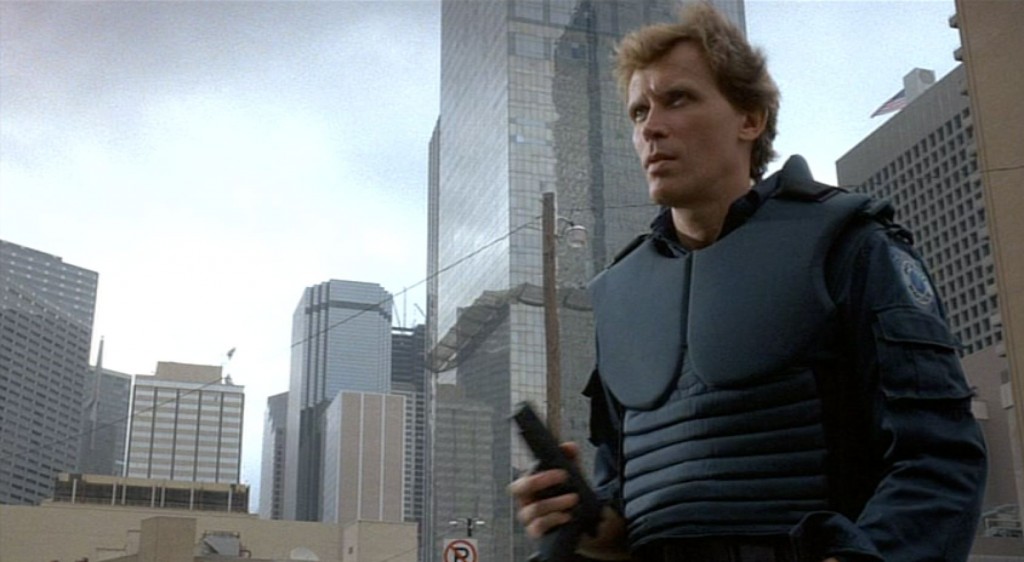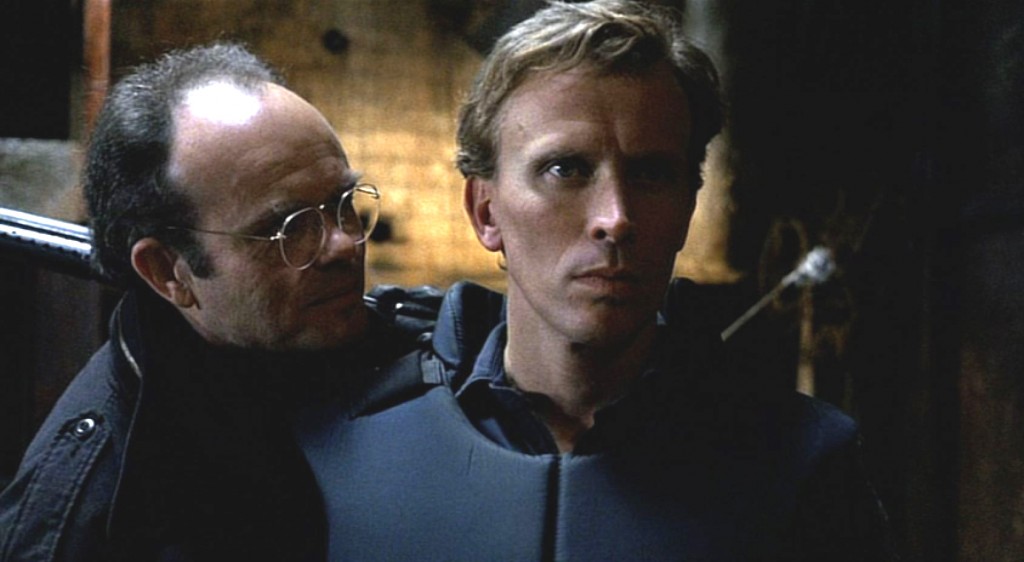Favorite screenplays: Robocop part 2
Murphy is a simple man who has been drafted into a complex, dangerous world. When we catch up with him at the fourteen-minute mark, he’s practicing his gun-twirling. Why is he practicing his gun-twirling? Murphy explains to spitfire partner Lewis, because there is a cop on TV, T.J. Lazer, who is a “good cop,” and whom Murphy’s son loves. So in the space of twenty seconds or so, we learn that Murphy is a dedicated father, loves his son, wants “to be good” for the sake of that son. The bashfulness with which he describes this intimacy to Lewis indicates that he is also in love with his wife. This is without staging a “family scene” that would dramatize all this. Again, that’s probably due to budget, since the screenplay is telling instead of showing, but it has a dramatic payoff: the screenplay, like Murphy, at this point takes his happy family for granted. He’s good, his son is good, his wife is good, he sees people as good, he’s about to get a lesson in how bad people can be. Like Jason Bourne, Murphy will be forced to rediscover who he is, and for the most part the viewer will be put in the place of the protagonist, which is an ideal place for a viewer to be.
Boddicker and his gang of thugs have robbed a bank – inefficiently. They have burned up their money in pursuit of their goal. Intentionally or not, Boddicker’s pursuit mirrors that of OCP’s, just on a more cutthroat level. They have a money-making plan that has been botched due to poor planning. Into this situation comes good cop Murphy.
Murphy and Lewis pursue Boddicker and his gang in their getaway van. Police rules of engagement in future Detroit are already pretty fast and loose, with police authorized to use lethal force without provocation, but Boddicker is still prepared to give the cops a run for their money. In his first clash of wits with Boddicker, Murphy is wily but Boddicker is brutal: when Murphy shoots one of Boddicker’s goons in the leg, Boddicker cuts his losses by throwing the goon out the back of the van onto Murphy’s car and making his getaway: again, a move Dick Jones would approve of.
Murphy and Lewis pursue the gang to an abandoned steel mill (as if there were another kind in Detroit). Lewis gets sandbagged by one giggling psychopath while Murphy overhears two other goons talking about Boddicker’s business plan: “We rob the bank to get the money to buy the coke to sell the coke to make even more money.” Vertical integration will eventually make itself part of Boddicker’s world (he is very much a dark shadow of Dick Jones), but for now he’s content to buy and sell (with other people’s money).
Murphy is able to sneak up on these business-talking goons while they are transfixed with the TV sitcom that always seems to be playing in the Robocop world. This show, apparently, deals with the broadly bawdy comedic exploits of a balding, bespectacled nerd, a kind of Mr. Peepers-meets-Benny Hill show, or perhaps the result of Russ Meyer getting a contract to produce a sitcom. Everyone from the board rooms of OCP to the crumbling ruins of Old Detroit apparently loves this show, the kind of pandering nonsense that is created to pacify a brutalized populace. The fact that the show’s catchphrase is “I’ll buy that for a dollar!” only cements its position as a capitalist tool.
Murphy gets the drop on the two goons and kills one, but the second, Emile, benefits from numbers: other gang members come to his rescue and Murphy is surrounded. For good capitalist-satire measure, there’s a beautiful shot where Emile knocks Murphy’s gun from his hand and it lands, plunk, in a basket of blood-soaked money.
Boddicker arrives and spits Murphy’s identity back at him: “You a good cop, hot shot?” he snarls, making the whole notion of “good cop” sound ugly and childish (and, perhaps it is somewhat childish, even to Murphy, who only wants to be a cop in the mode of T.J. Lazer). The gang, laughing and jeering, shoot Murphy to pieces, the murder of a police officer only slightly more entertaining to them than the bawdy sitcom. Boddicker, an evil man but not really a sadist, puts Murphy out of his misery with a bullet to the head. Later, we will learn that Boddicker has been in cahoots with Dick Jones the whole time; it’s ironic that his murder of Murphy directly benefits Jones’s business rival Morton.
But of course Murphy is not actually dead, and when corporate profits are at stake, mountains get moved to save a good cop’s life. A large, swift medical team, funded, I assume, by Morton’s end of OCP, rush to get Murphy patched up and re-booted as Robocop.
As Murphy dies on the operating table, he has flashbacks to his previous life: he comes into his living room to find his son watching T.J. Lazer (and we find that the title character’s charm comes from his astonishing accuracy, murdering criminals with his laser gun sight — even children’s entertainment in this world celebrates high-tech brutality. He also has a bedroom encounter with his wife, which threatens evidence of a stormy marriage. He then sees his wife and child waving to him at the end of his idyllic suburban driveway, presumably as he’s driving to work on his first day at Metro West. Finally, he re-lives his torture and murder at the hands of Boddicker and his goons. There’s then a cut to black, followed immediately by a cut to electronic “snow,” as Murphy is re-born as Robocop. Few first acts in movies are simpler than Murphy’s: show up for work, go out on a call, get killed. It’s as brutally economic as the world it satirizes.


Murphy’s death has always been one of the most brutally terrifying scenes I’ve ever experienced in my movie-going days. I saw the movie in the theater when I was 10 (how’s that for a healthy home life?) and remember it shaking me to my core. Here’s a guy, just out to be “a good cop” as you so clearly state, he’s just out to clean up the streets and make the world a safer place for his family, when BAM! he’s massacred by the most horrible scum in all of Detroit on what is probably HIS FIRST DAY ON THE JOB. Worse, he is alone, without help (Lewis may be good at chewing bubble gum but she sure can’t take a punch), and shrieking at the top of his lungs while he’s shot to pieces by this gang, who laugh and jeer at him like it’s the most casual thing on the planet.
When Boddicker blasts off Murphy’s hand I couldn’t believe my eyes, as if it never even occurred to me that such violence occurred in the world, let alone that they could show that type of thing in movies. (The unrated version – which, you’ll remember, received an “X” rating when Verhoeven originally submitted it to the MPAA – is even worse, elongating Murphy’s reaction to his blown-off hand and showing his shock when a second shotgun blast shears off his remaining arm.) Imagine the horror of that moment, what you’d be thinking if you were in Murphy’s shoes. As Verhoeven himself intended, it makes it all the more satisfying when Murphy/RoboCop takes his revenge, so that every act of violence is justified.
This, by the way, is the most curious thing about the movie’s ultra-violence: that it’s appropriately shocking and sad to see this cop we’ve barely met tortured and mutilated in such graphic detail, but later, when he fights back (specifically, I’m thinking of the scene where Emile is literally melted by toxic waste) we are cheering him on, as if the gore is suddenly okay. But that’s more at a directorial level than anything included in the screenplay.
Emile’s death is thrilling and comic, but it’s important to note that he totally brings it on himself. He drives the van into the tank of toxic waste, then Boddicker hits him with his 6000 SUX. His death is a little comic suite actually, showing the steps of Emile’s criminal life, from blunder to denial to disintegration, coming to an end. We get to laugh because Murphy has no responsibility for it. If the scene was Murphy thrusting Emile into the toxic waste, then letting him go, then laughing maniacally as he ran him down, then yes, we’d have reservations about the violence.
But the fact is, people like to see violence in movies, whether it’s landing the punch of Murphy’s death or scoring hearty laughs at a character’s expense. Murphy’s death is like something out of Shakespeare, but Emile’s death is strictly Roadrunner. Verhoeven was a master of walking that line and manipulating the audience’s perception of it.
Excellent point. And I love the way you phrased it, “Verhoeven WAS [my capitalization] a master.” Good to see he went back to his Dutch roots with BLACK BOOK…